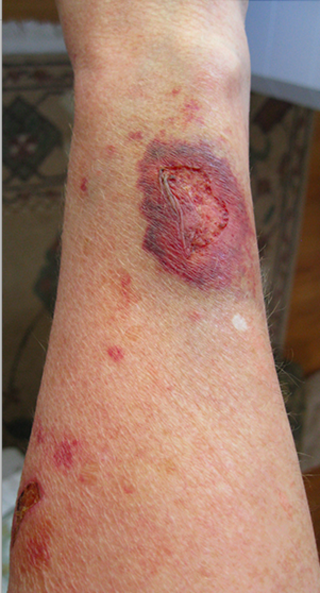
Pimecrolimus is an immunomodulating agent of the calcineurin inhibitor class used in the treatment of atopic dermatitis (eczema). It is available as a topical cream, once marketed by Novartis under the trade name Elidel.

Betamethasone is a steroid medication. It is used for a number of diseases including rheumatic disorders such as rheumatoid arthritis and systemic lupus erythematosus, skin diseases such as dermatitis and psoriasis, allergic conditions such as asthma and angioedema, preterm labor to speed the development of the baby's lungs, Crohn's disease, cancers such as leukemia, and along with fludrocortisone for adrenocortical insufficiency, among others. It can be taken by mouth, injected into a muscle, or applied to the skin, typically in cream, lotion, or liquid forms.

Desonide (INN) is a low-potency topical corticosteroid anti-inflammatory that has been available since the 1970s. It is primarily used to treat atopic dermatitis (eczema), seborrheic dermatitis, contact dermatitis and psoriasis in both adults and children. It has a fairly good safety profile and is available as a cream, ointment, lotion, and as a foam under the tradename Verdeso Foam. Other trade names for creams, lotions, and ointments include Tridesilon, DesOwen, Desonate. It is a group VI corticosteroid under US classification, the second least potent group.

Fluticasone propionate, sold under the brand names Flovent and Flonase among others, is a steroid medication. When inhaled it is used for the long term management of asthma and COPD. In the nose it is used for hay fever and nasal polyps. It can also be used for mouth ulcers. It works by decreasing inflammation.

Betamethasone dipropionate is a glucocorticoid steroid with anti-inflammatory and immunosuppressive abilities. It is applied as a topical cream, ointment, lotion or gel (Diprolene) to treat itching and other skin conditions such as eczema. Minor side effects include dry skin and mild, temporary stinging when applied. Betamethasone dipropionate is a "super high potency" corticosteroid used to treat inflammatory skin conditions such as dermatitis, eczema and psoriasis. It is a synthetic analog of the adrenal corticosteroids. Although its exact mechanism of action is not known, it is effective when applied topically to cortico-responsive inflammatory dermatoses. It is available as a generic medication.

Betamethasone valerate is a synthetic glucocorticoid ester. It is the 17-valerate ester of betamethasone. Betamethasone valerate is often used to treat mild eczema with good efficacy and lower incidence of steroid induced adverse effects due to its lower potency compared to other glucocorticoids. Betamethasone-17-valerate is available in cream, ointment, lotion, and foam preparations for topical use.

Fluocinonide is a potent glucocorticoid used topically as an anti-inflammatory agent for the treatment of skin disorders such as eczema and seborrhoeic dermatitis. It relieves itching, redness, dryness, crusting, scaling, inflammation, and discomfort.

Desoximetasone is a medication belonging to the family of medications known as topical corticosteroids. It is used for the relief of various skin conditions, including rashes. It helps to reduce redness, itching, and irritation. Desoximetasone is a synthetic corticosteroid, a class of primarily synthetic steroids used as anti-inflammatory and anti-pruritic agents.

Alclometasone is a synthetic corticosteroid for topical dermatologic use, possessing anti-inflammatory, antipruritic, and vasoconstrictive properties.

Mometasone, also known as mometasone y 3 s, is a steroid medication used to treat certain skin conditions, hay fever, and asthma. Specifically it is used to prevent rather than treat asthma attacks. It can be applied to the skin, inhaled, or used in the nose. Mometasone furoate, not mometasone, is used in medical products.

Clobetasone (INN) is a corticosteroid used in dermatology, for treating such skin inflammation as seen in eczema, psoriasis and other forms of dermatitis, and ophthalmology. Topical clobetasone butyrate has shown minimal suppression of the hypothalamic–pituitary–adrenal axis.

Diflorasone diacetate is a topical steroid that comes in the form of a cream. It is manufactured by E. Fougera & Co. and is used as an anti-inflammatory and anti-itching agent, like other topical corticosteroids. It is prescribed for psoriasis and atopic dermatitis, among other conditions. With respect to potency, it is regarded as a Class I corticosteroid [of classes I – VII] in the United States.

Amcinonide is a topical glucocorticoid used to treat itching, redness and swelling associated with several dermatologic conditions such as atopic dermatitis and allergic contact dermatitis. Amcinonide can also be classified as a multi-functional small molecule corticosteroid, which has been approved by the FDA and is currently marketed as an ointment, lotion, or cream. It acts as both a transcription factor for responses to glucocorticoids and modulator for other transcription factors while also regulating phospholipase A2 activity.
In medicine, a finger tip unit (FTU) is defined as the amount of ointment, cream or other semi-solid dosage form expressed from a tube with a 5 mm diameter nozzle, applied from the distal skin-crease to the tip of the index finger of an adult. The "distal skin-crease" is the skin crease over the joint nearest the end of the finger. One FTU is enough to treat an area of skin twice the size of the flat of an adult's hand with the fingers together, i.e. a "handprint". Two FTUs are approximately equivalent to 1 g of topical steroid.

Steroid-induced skin atrophy is thinning of the skin as a result of prolonged exposure to topical steroids. In people with psoriasis using topical steroids it occurs in up to 5% of people after a year of use.
Topical steroids are the topical forms of corticosteroids. Topical steroids are the most commonly prescribed topical medications for the treatment of rash and eczema. Topical steroids have anti-inflammatory properties and are classified based on their skin vasoconstrictive abilities. There are numerous topical steroid products. All the preparations in each class have the same anti-inflammatory properties but essentially differ in base and price.
EpiCeram is a topical non-steroidal skin cream. Based on the research of Peter M. Elias, it is made up of ceramides, free fatty acids, and cholesterol, and is designed to treat atopic dermatitis, a type of eczema. Ceragenix obtained marketing clearance from the U.S. Food and Drug Administration in April 2006. This prescription medical device works as a moisturizer and barrier cream. In the US, it requires prescription and was launched in October 2008 by Promius Pharma. EpiCeram was acquired by PuraCap Pharmaceutical LLC in 2010.

Calcipotriol/betamethasone dipropionate, sold under the brand name Taclonex among others, is a fixed-dose combination medication of the synthetic vitamin D3 analog calcipotriol (also known as calcipotriene) and the synthetic corticosteroid betamethasone dipropionate for the treatment of plaque psoriasis. It is used in the form of ointment, topical suspension, gel, aerosol, and foam.

Topical glucocorticoids are the topical forms of glucocorticoids. Topical glucocorticoids are used in the treatment of many skin conditions. They provide anti-inflammatory, antimitotic, and immune-system suppressing actions through various mechanisms.

Topical hydrocortisone is a drug under the class of corticosteroids, which is used for the treatment of skin inflammation, itchiness and allergies. Some examples include insect bites, dermatitis and rash.

















